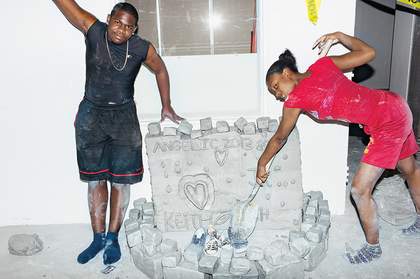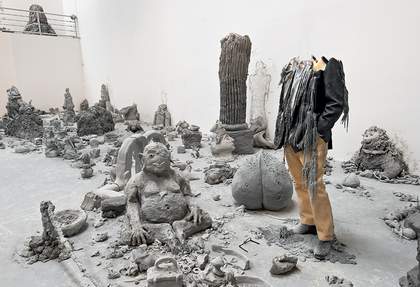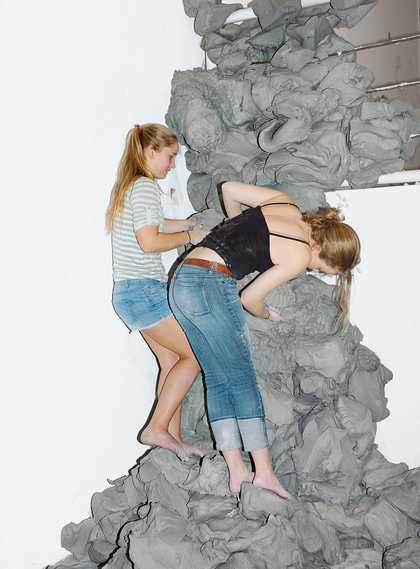Alongside Urs Fischer’s exhibition at the Museum of Contemporary Art in Los Angeles in the summer of 2013 was a second show at MOCA’s sister gallery, Geffen Contemporary, that consisted of a 25-day art event featuring 1,500 volunteers, including amateurs and art students… and 300 tons of clay.
There are hundreds of sculptures that grow to massive proportions or crumble to nothing, rising as clumps and clusters or presenting themselves to our eyes as erratic individual pieces in the labyrinthine rooms and halls of Geffen Contemporary. The exhibition covers almost every centimetre of available space, including stairs, landings and door handles - an intricate, fantastical tectonic with cleared walkways. That’s what the presentation of collectively exploding creativity looks like in concrete terms. With the title Yes!, the whole thing has some rather gruesome features and might at times be a little oppressive, but it’s also hugely cheering and exerts a magical, even hypnotic attraction. Looking at it, one gains a quite physical idea of a joyful experience: the concentrated happiness of earth-bound sensual making.

Installation view of Urs Fischer’s clay project Yes! at Geffen Contemporary, Los Angeles, August 2013
Photographed by Cassandra Macleod
The supervision of the ‘creators’ (or should we call them ‘proto-artists’?) was typical of Urs Fischer, the spiritual father of the action. He communicated brief instructions, such as: ‘Everything is allowed, except that the walls are to remain untouched’ - which for a few amounted to an invitation to transgress. He ensured appropriate musical stimulation, inviting the pianist Pete Drungle, a major figure on the New York scene, to play non-stop from 10.00 until 17.00 on a Steinway D piano, taking only a small lunch break. The two ‘chefs’, Mina Stone and Alex Eagleton, provided the inspiringly sophisticated food for the feeding of the more-than-a-thousand. Between twenty and 200 volunteers, art students or people prompted by an internet appeal or word of mouth, turned up every day.

Installation view of Urs Fischer’s clay project Yes! at Geffen Contemporary, Los Angeles, August 2013
Photographed by Brian Forrest
Inside - in the sea of bodies, hands, feet, open mouths, noses, ears, octopuses, sharks, penises and vaginas, mermaids, captains, Napoleons, chained and entangled figures, rats, mice, foxes, tigers, snakes, worms, walls, coral reefs, crying babies, caricatures of, for example, Rodin’s The Thinker, or things completely abstract, geometrical and even convulsively distorted, mass-miniaturised or monstrously magnified - one suddenly came across discreetly smuggled in pieces by Fischer.
Some of his candle sculptures burned quietly away, such as the big wax copy of Giambologna’s Rape of the Sabine Women c.1583. This alone was a memorable monument, the reflection of a once culturally idealised benchmark. Its presence created friction with the evoked ideal, not only through the now drippingly transient form as a sticky candle, but also in the context of the other burgeoning shapes and forms.
Here at last one could guess what Fischer was probably thinking when he issued his appeal for volunteers and took all that effort. (Incidentally, he has organised similar events several times in Europe on a smaller scale, as in Venice in an open courtyard, where he gave the participating art students a subject: ‘cat’ or ‘feet and hands’.) It is a matter of presenting the artist as we know him as a part of the ‘art world’: a solo player with a studio and maybe assistants, but also a highly professionalised creature who, if he or she is successful, has arisen out of the majority of the many, embodied in us all.

Installation view of Urs Fischer’s clay project Yes! at Geffen Contemporary, Los Angeles, August 2013
Photographed by Cassandra Macleod
But in the end it isn’t just about the role of the artist. It’s about all of us in the age of the internet, given the spontaneity and mass creativity coursing digitally through the universe, and the resulting desire for crystallisation, for something to hold on to, for a valid set of values. And the longing to overcome alienation and connect with the surge of life.
Fischer’s clay work, so present as a material in this exhibition, always makes us think of his recurring preoccupation with the earth. Thus, he once created a copy of a freshly dug grave, cast in bronze, which could be seen from inside and out and from below over two floors of a gallery. On another occasion he had a huge hole excavated in the floor of his New York gallery that almost made the whole building collapse. Standing outside Geffen Contemporary was one of his gigantic cast-aluminium sculptures, vast enlargements of a small kneaded clay figure. Even from far off it was possible to make out the artist’s fingerprints - a highly ambiguous contemporary memento for the ‘outstanding’, as well as for the lasting and the obsolete
